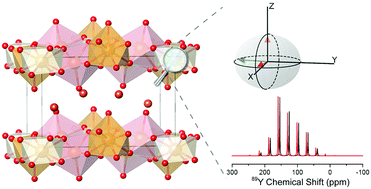89Y chemical shift anisotropy: a sensitive structural probe of layered yttrium hydroxides revealed by solid-state NMR spectroscopy and DFT calculations†
Abstract
Anion-exchangeable Y2(OH)5X·nH2O (LYH-X, X = monovalent anions, n ≈ 1.5) materials are an ideal platform for incorporating the unique properties of layered metal hydroxides and rare-earth (RE) ions, and thus have exhibited promising prospects for various applications. To further improve the performance of LYH-X and related functional materials, their structure–property relationships must be explored. However, due to the intrinsic felxibility, extracting the local structural details of these materials is particularly challenging. In this work, we utilized a combined approach of 89Y solid-state NMR (ssNMR) spectroscopy and density functional theory (DFT) calculations to reveal the response of 89Y chemical shift anisotropy (CSA) in LYH-X to the structural changes including a small displacement of cationic yttrium hydroxide layers and intercalated anions. Such subtle structural changes are often associated with dehydration/rehydration, anion-exchange, exfoliation, and the self-assembly process of LYH-X and related functional materials, which are exceedingly difficult to detect using other techniques. The principal components of 89Y CSA show a larger variation range than isotropic chemical shifts, making CSA a more sensitive probe. In addition, it is found that the response of 89Y CSA to structural changes is distinct for Y sites with different local coordination environments, opening great opportunities to analyze each Y site within these materials. All these observations suggest that the strategy involving both experimental (89Y ssNMR) and theoretical (DFT) approaches can be utilized to extract previously unavailable ultrafine structural information of LYH-X and related materials, and provide fruitful insights into their thorough structure–property relationships.



 Please wait while we load your content...
Please wait while we load your content...